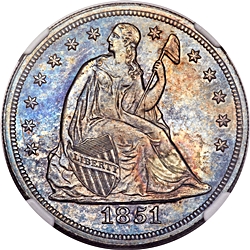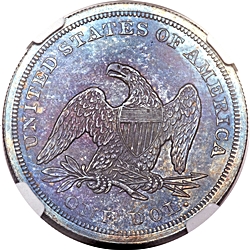 |
1851 
 |
 |
General Comments1851 silver dollars are truly rare in all grades. The highest currently graded business strikes are two MS65 examples, one graded by PCGS, the other by NGC. PCGS has graded six coins MS64. NGC has graded one at that level. At the MS63 level PCGS has graded two coins, NGC nine, with one of those nine graded MS63+. It’s probable that these 20 choice mint state records represent at most 12 to 15 coins. PCGS has graded an additional 11 coins in grades MS60-MS62. NGC has graded 8 in that range. In circulated grades, the available coins are even fewer. PCGS has graded only 15 coins below mint state. Only 3 are below AU – one VG8, one VG10, and one XF45. NGC has graded only eight below mint state, all AU’s. The collector developing a set at the XF or lower level has a choice between waiting possibly many years for a single opportunity to obtain the date or filling the hole with a higher-grade coin. Population statistics are as of January, 2020. |
| |||||||||||||||||||||
1851 business strikes are usually well struck. Star centrals and hair detail are well defined. Some examples show slight weakness on the top of the eagle’s left wing. High-grade business strikes are sometimes semi-prooflike, but more often frosty. Fully prooflike examples are rare. It’s hard to be picky about the strike and surfaces when looking for this date, as nice examples are seldom seen in any grade.
1851 Proofs
1851 proofs deserve a separate discussion. Original 1851 proofs may not exist. We believe that it’s probable that one or two examples exist, but none have been confirmed. We’ve identified the original proof as die marriage OC-P1, and left a place for it in our listings. If these exist the obverse might be the business strike obverse, Obverse 1, but more likely one of the two known proof obverse dies, or possibly a currently undocumented proof obverse. The obverse would almost certainly be paired with Reverse 1840 PA. Confirmed proofs paired with this reverse exist for every year from 1840 through 1854 except 1851 and 1853, and we believe that all are originals.
All documented 1851 proof examples are restrikes. Estimates of the proof restrike mintage vary from 50 to 100. We believe that the correct estimate is probably around 75, with about 60% of those surviving today. The finest known 1851 restrikes are two coins graded PR65 Cameo, one by PCGS and one by NGC. The PCGS example, the Kaufman coin, was originally in an NGC PR66 Cameo holder. This coin is an example of the OC-P3 die marriage. Each grading service lists one additional coin at the PR65 level. The PCGS population report shows four additional coins graded PR64, with one of those rated as a cameo. The NGC population report shows four at the PR64 level. The grading services list a total of 48 coins currently graded, 30 at PCGS and 18 at NGC. At least a dozen of these grading records surely represent re-submissions. Population statistics are as of January, 2019.
1851 proofs are usually found well-struck, with all design elements sharply defined. Cameo contrast is common on all proof restrike die marriages.
1851 proof restrikes have been known since the 1860’s, although at that time they were not necessarily considered restrikes. As time passed more research was done, and more was learned. Walter Breen, in his epic encyclopedia of U. S. proofs (Reference 7) identified a single obverse die, and mentioned that multiple reverse dies may exist. David Bowers (reference 4) identified two die marriages, with two different obverse dies each paired to a unique reverse. His descriptions of the obverse die markers were excellent, although one detail, the unfinished area under Miss Liberty’s chin, or “beard”, was attributed to the wrong obverse. Most literature has speculated, based on circumstantial evidence only, that restrikes were created in the 1858-59 timeframe, and again in 1865-1867.
Why were the restrikes created? Based on letters documented in references 4 and 16 it’s clear that mint officials wanted examples of rare dates both to sell to collectors and to trade to collectors for coins and medals needed to expand the mint cabinet. Collectors of that day weren’t particularly interested in business strikes. They wanted proofs. The 1851, with an original proof mintage that was either tiny or non-existent, qualified as a rare or possibly unavailable date, and thus was an obvious restrike candidate.
Based on our analysis of 1851 dies we can confirm that 3 different restrike die marriages were created, using 2 obverse dies and 3 reverses. None of these dies were used for business strikes. The first die marriage, our OC-P2, pairs our Obverse P2, the one referred to as obverse 2 by Bowers, with the reverse die used to strike original proofs in 1856, 1857, and 1858. The second die marriage, our OC-P3, also uses our Obverse P2, pairing it with the reverse die used to strike all 1859 original proofs. The third die marriage, our OC-P4, pairs our Obverse P3, the one referred to as obverse 1 by Bowers, with the reverse die used to strike almost all 1865 original proofs. All these die marriages are described in detail later in this chapter.
Our estimates of when the restrikes might have been created are based on the same circumstantial evidence others have used, but aided by our having identified the specific reverse dies that were used for each restrike. The 1851 restrikes were minted in two, possibly three timeframes. The first restrike, our die marriage OC-P2, mated a new or at least previously unused obverse die, our Obverse P2, to Reverse 1856 PA, the die previously used to strike original proofs from 1856, 1857, and 1858. The timeframe for this striking is simply an educated guess. We believe that they were struck in late 1858 or early 1859, after the reverse die was used to strike 1858 originals. Examples of this die pair are extremely rare. The only example we’ve confirmed is the coin sold by David Lawrence Rare Coins as part of the Richmond collection.
The second restrike, our die marriage OC-P3, paired Obverse P2 with Reverse 1859 PA, the reverse die used to mint all 1859 proofs. We believe that they were minted in late 1859 or early 1860. We identified the timeframe for their striking by noting that Reverse 1859 PA wasn’t carried over to strike 1860 proofs, so we assume that it was retired soon after its use in 1859, and would only have been available for a short period.
The third restrike, our die marriage OC-P4, mated a new or at least previously unused obverse die, our Obverse P3, with the reverse die used to strike almost all 1865 proofs. We believe that they were minted in late 1865 or early 1866. Again, we identified the timeframe for their striking by noting that Reverse 1865 PA wasn’t carried over to strike 1866 proofs, so we assume that it was retired soon after its use in 1865, and would only have been available for a short period. Another factor that supports this conclusion is the change that occurred in 1866, from the NO MOTTO reverse to WITH MOTTO. Additionally, we note a record that the first sale of a copper 1851 dollar, J-132, was in October, 1865 (reference 16). This pattern used the same dies as our OC-P4 die marriage.
1851 Die Marriages
We’ve confirmed a total of 4 die marriages for 1851, 3 of them proofs. A fifth die marriage is possible if the original proof exists. We’ve left a place in our die marriage listings to accommodate this possibility. The following table summarizes the known die marriages.
Die Marriage |
Rarity |
Obverse Die |
Reverse Die |
Estimated Survivors |
| OC-1 | R5 | 1 | 1848 A | 50 |
| OC-P1 | Unconfirmed | P1? | 1840 PA | None Confirmed |
| OC-P2 | R8 | P2 | 1856 PA | 3 |
| OC-P3 | R6- | P2 | 1859 PA | 25 |
| OC-P4 | R6+ | P3 | 1865 PA | 17 |
A single pair of dies was used to strike all business strikes. We’ve identified the business strike die pair as OC-1. Neither die was used for proofs. The obverse is known as the “high date”. The date position is much higher in the field than either of the proof dies, and slants slightly down to the right. Almost all examples seen exhibit light obverse clash marks in the field under Miss Liberty’s arm. The dies apparently clashed very early in the mintage. Unclashed examples are seldom seen. The reverse die was originally used to strike 1848 business strikes, and was re-used in 1849 and 1850. The die is almost certainly clashed in most of its 1851 usage, but the clashing is very light. A vivid imagination is required to detect it.
The original issue 1851 proof is unconfirmed, but we’ve assumed that a small number probably exist. Restrikes were minted in three different timeframes. They mated two different obverse dies, neither used for business strikes, with reverse dies that were first used for regular issue proofs in later years.
1851 Business Strike Emission Sequence
With only a single die marriage the emission sequence isn't terribly interesting.
Emission Order |
Die Marriage |
Comments |
| 1 | OC-1 |
1851 Proof Emission Sequence
We assume that the original 1851 proof, if it exists, is the first issue. The 3 restrikes were placed in the emission
sequence based on the original timeframes of reverse die usage. The degradation of the obverses during their use wasn’t enough
to conclusively confirm the emission sequence.
Emission Order |
Die Marriage |
Comments |
| 1 | OC-P1 | If it exists this is the only original proof die marriage. |
| 2 | OC-P2 | This die marriage uses the reverse die first used for original proofs of 1856, 1857 and 1858. |
| 3 | OC-P3 | This die marriage uses the reverse die first used for original proofs of 1859. |
| 4 | OC-P4 | This die marriage uses the reverse die first used for original proofs of 1865. |
1851 Quick Finder Chart
1851 die marriages are easy to attribute. The only dies that are difficult to differentiate are Obverses P2 and P3. With each married to a
different easy-to-attribute reverse they don't present a problem.
Die Marriage |
Obv. Die |
Rev. Die |
Right Base |
Keys to Identification |
| OC-1 | 1 | 1848 A | JL of RE | Obverse – High date. Reverse - A heavy die line slants down to the right through the horizontal shield lines near the right side of the shield. |
| OC-P1 | P1? | 1840 PA | Unknown | Obverse – Unknown Reverse – Defects inside the upper triangle of A3. |
| OC-P2 | P2 | 1856 PA | C | Obverse – Low date. Only 25% unfinished under the chin. Reverse – Rust lumps on top of L in DOL. |
| OC-P3 | P2 | 1859 PA | C | Obverse – Low date. Only 25% unfinished under the chin. Reverse – Lumps in lower left wing feathers. |
| OC-P4 | P3 | 1865 PA | JR of C | Obverse - Low date. Almost 100% unfinished under the chin. Reverse - Doubled die, visible as a widening of the top of UNI. Die polish at the top of the first set of vertical shield lines. |
| Photo credits:
Obverse and reverse full photos: NGC MS63, ex. Gene Gardner, from the Heritage archives. |
